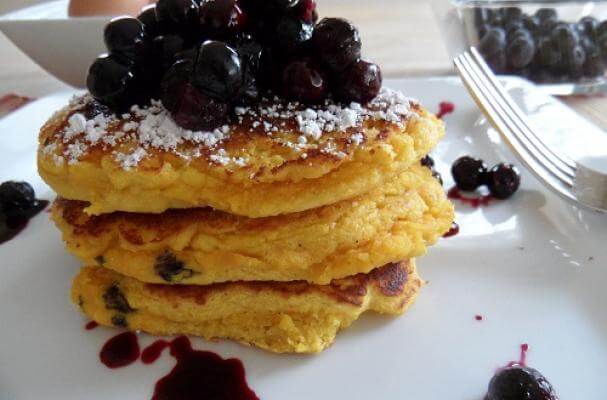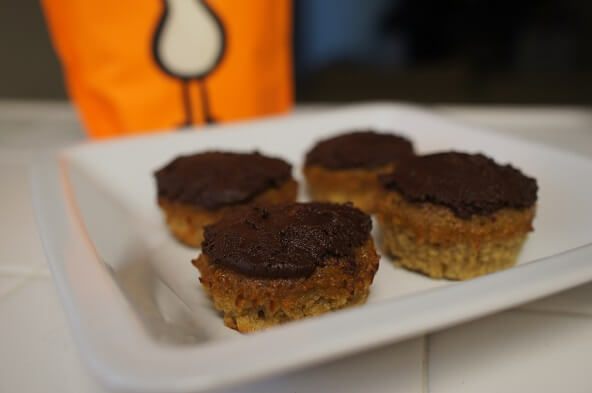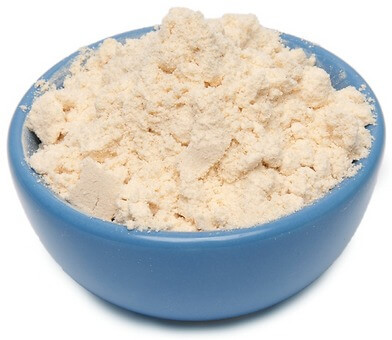Nuts.com’s Guide to Baking with Coconut Flour

Baking with coconut flour takes some getting used to, but with a few tips and tricks you can begin making delicious gluten-free baked goods. Follow us as we explore the benefits of coconut flour, what you need to know when baking with it, and a handful of recipes for anyone starting out.
What is Coconut Flour?
Coconut flour is the byproduct of coconut milk production; it comes from the defatted coconut meat that is leftover once the milk of the coconut has been pressed out. The dried coconut meat is ground to produce a fine, soft flour.
The Benefits of Coconut Flour
1) It’s a powerhouse of fiber. Just ¼ cup of coconut flour provides 12 grams of fiber. Most of this fiber is the insoluble kind, which promotes a healthy digestive system. It also gives you a feeling of fullness so you’ll be less likely to overeat later in the day.
2) It’s a low-glycemic food. Coconut flour has a low glycemic index, meaning that it won’t cause large spikes in blood sugar levels typically associated with wheat flours. Its low-GI is due to its high fiber content which delays carbohydrate digestion and entry into the bloodstream.
3) It’s suitable for many diets. Coconut flour is naturally gluten-free, so it’s a perfect option for gluten-free and grain-free diets. It’s low-GI appeals to low-carb dieters, diabetics, and those watching their glycemic index. People following the paleo diet also love coconut flour because they can use it to make paleo-approved treats.
4) It can produce soft, delicious baked goods. Baking with coconut flour is an art, and with the right recipe and your own experimentation, you can be well on your way to making moist and wonderful pancakes, muffins, cupcakes, and more. You just need to know a few tips.
Best Tips for Baking with Coconut Flour
1) Coconut flour behaves differently than grain-based flours. You cannot merely do a one-to-one replacement of coconut flour for wheat flours in your recipes. As a very general rule of thumb for baked goods, 1/4 – 1/3 cup of coconut flour can be substituted for 1 cup of wheat flour.
Gluten-free batters tend to be thicker than those made with wheat flours. They don’t pour as easily, and often need to be spread out into the pan. Since coconut flour tends to clump, make sure you are meticulous in beating the ingredients together.
2) Coconut flour is HIGHLY absorbent. It absorbs eggs, liquids, and oils like a sponge. For baked goods, if you are substituting coconut flour for a wheat flour, it’s recommended that you use more eggs in the recipe to provide necessary moisture. Typically, each ½ cup of coconut flour in a recipe should be accompanied by 3 eggs and about 1/2 cup of liquid like milk (cow, soy, almond, coconut, etc.). Greek yogurt can also help make baked goods more tender. Baked goods made with coconut flour will turn out dry if the recipe does not use enough eggs or wet ingredients.
Since gluten affects the texture and structure of baked goods, the tricky thing about gluten-free baking is that you have to make up for this absence. The great thing about eggs is that they provide structure. You can even let the coconut flour mixture soak in the wet ingredients for 15-20 minutes before transferring it to the oven to avoid a grainy texture.
Egg alternatives for vegans and those with egg allergies: Make a ‘flaxseed egg’ by using 1 tbsp flaxseed meal & 3 tbsp water in place of every egg. You can also get creative with additions like applesauce, mashed bananas or other soft fruit in your recipes to make them more moist.
3) Try coconut flour recipes first, before you begin experimenting on your own. Since baking with coconut flour can be a finicky process, we recommend relying on tried and true recipes that have been specifically developed using coconut flour. Start out with an easy pancake or muffin recipe before moving on to cakes and breads.
As you become more familiar with how coconut flour behaves and absorbs other liquids, you can move on to more adventurous baking endeavors. If the batter is ever too dry, you can slowly add more liquid or eggs. If it’s too thin, a touch of coconut flour will help. Feel free to experiment with the consistency. Working coconut flour into recipes that traditionally use grain-based flours can be very rewarding once you get the hang of things.
4) Foods made with coconut flour will have a slight coconut-ty flavor. For those that don’t enjoy the flavor of coconut, you can still use the flour in combination with more dominant flavors that will mask the coconut taste. Try cocoa in chocolate cakes and cupcakes, or herbs & spices in breads. On the other hand, if you adore all things coconut, you can bring out that flavor even more by adding other coconut products into your baking, such as coconut milk, coconut oil, and shredded coconut.
5) On average, 1/4 cup of coconut flour is equal to 1 ounce. If you want to be precise, you can measure the coconut flour with a digital food scale. Otherwise, scoop the coconut flour out of the bag with your measuring cup and level it off with a knife. It’s best not to pack it into the measuring cup.
6) Coconut flour makes a delicious coating for meats & veggies. If breading meat, poultry, fish or vegetables with coconut flour, it can replace the wheat flour as a one-to-one substitute. Make sure you use enough oil because coconut flour is very absorbent, and the coating will turn out dry if there isn’t enough oil for the coconut flour to soak up. Coconut flour can also be used as a substitute for breadcrumbs in meatloaf and meatballs; just use twice as much liquid as the recipe calls for.
Coconut Recipes for Starters
1) Coconut Flour Pancakes – An easy breakfast treat!
2) Banana Coconut Flour Muffins – Enjoy these as a nutritious snack.
3) Coconut Fried Fish – Give your favorite fish fillets a crispy coating.
4) Coconut Flour Flax Bread – This quick bread is nutritious and packed with fiber.
5) Black Walnut Chocolate Chip Cookies – A new take on chocolate chip cookies!
Have you ever tried baking with coconut flour? Tell us about your experience by leaving a comment below.



4 Responses to “Nuts.com’s Guide to Baking with Coconut Flour”
The real problem I find with coconut flour though, is the unimaginably dense, almost gel like quality it produces in baked goods, making centers over moist, heavy, and in no way bready. This issue wasn’t addressed at all in the article.
Also, using straight coconut flour for breading and frying, while tasty, always comes out gritty for me. Too much unbroken fiber.
Any thoughts on these issues?
Hi Dawn – Thanks for your questions! Coconut flour is best for quick bread recipes such as muffins, biscuits, banana bread, pancakes, etc. Coconut flour tends not to produce soft and fluffy bread like sandwich bread, unless you mix it with a combination of other gluten-free flours.
When breading or frying with coconut flour, make sure you use plenty of oil since coconut flour is very absorbent. This will help make the crust more tender.
I prefer coconut flour over garbanzo bean flour. I just always use a combination of almond flour, pecan flour, flax flour, and coconut flour. I add chia seeds/chia flour in a lot of my muffins too. I use veggies or applesauce for the moisture. Still a lot to learn with cooking since replacing plain flour is so different using nut flours BUT the best thing is it is so much better for us. Thanks for the tips.
Hi Cathy – Thanks for stopping by and for sharing your baking suggestions with us. We’ll have to try your blend of flours!